Science / Functional Breathing Technique / How to Breathe While Running
How to Breathe While Running
Why You Must Learn to Keep Your Mouth Shut and Breathe Through Your Nose During Exercise.

Frustrating, isn’t it? When even expert advice is contradictory, it can be hard to know how to breathe while running. Writing for Adidas Runtastic, one bronze medal-winning canoeist states: “It is not a good idea to deprive your body of a way of achieving maximum oxygen uptake when your body is under stress. As the intensity of your running increases, you will soon see that you cannot get enough oxygen by simply breathing through your nose.”
Dr. George Dallam disagrees. Dallam is professor of exercise science and health promotion at CSU-Pueblo. He’s also a former USA Triathlon National Team coach. He has conducted detailed studies into the benefits of nose breathing for runners, and what constitutes proper breathing while running. Dallam says false assumptions about mouth breathing are creating, “a nearly epidemic rate of exercise-induced bronchoconstriction in endurance athletes.” We’re running ourselves into an asthmatic state.
Dallam’s research challenges the assumption that mouth breathing is superior. His results demonstrate the opposite — that the best breathing technique for running is through the nose.
Nasal Function and Dysfunction in Exercise
As well as general functions, like filtering, humidifying and warming the air we breathe, the nose plays an important role in overall health, regulating blood pressure and helping the body fight infection. However, exercise can have negative effects, causing the nasal cavity to swell and restrict airflow.
Common nasal dysfunctions that can occur during exercise include a congested nose and in more extreme cases, the mucous membranes in the nose dry out causing crusting and bleeding and making breathing difficult. Also, changes in air pressure can lead to a lot of pain and pressure in some people’s sinuses when exercising.
Causes of Nasal Dysfunction During Exercise
The most common biological cause of nasal dysfunction is an increase in nasal secretions, which can be caused by the body’s response to heat, humidity, or exercise itself.
Physiological factors that can cause nasal dysfunction include blood pressure, heart rate, and airflow changes. While environmental conditions such as pollution and high winds can also negatively contribute.
How to Improve Nasal Function
Before you exercise, practices such as nasal irrigation can help to clear your nasal passages and improve airflow. You can also try using a decongestant or nasal spray to help open your sinuses.
However, a simple drug-free exercise to clear the nose can also be found on the Oxygen Advantage® YouTube channel.
During exercise, it’s important to stay hydrated and drink plenty of water. This will help keep your nasal passages moist and prevent them from drying. You can also try wearing a nose clip to keep your nose open.
After exercise, it’s important to take some time to relax and recuperate. This will help your body expel any built-up heat and moisture and allow your nasal passages to return to their normal size.
The importance of nasal function during exercise cannot be overemphasized. When nasal function is impaired, a number of health impacts can result, ranging from minor annoyances to life-threatening conditions. In addition, nasal dysfunction can profoundly impact lifestyle, making it difficult or impossible to participate in many activities.

Quick Tips
Your ability to run with your mouth closed depends on:
- Your BOLT score. A higher BOLT score translates into lighter breathing.
- Your nasal airway. A well-developed nasal airway can handle a larger volume of air.
- Your fitness levels.
When to breathe through the nose during running?
- Low to moderate-intensity exercise: continue with nasal breathing in and out.
- Moderate to high-intensity exercise: breathe in through the nose and out through the mouth
- High-intensity exercise: breathe in and out through the mouth
Run with your mouth closed as much as you can. When the air hunger is too strong, switch to mouth breathing.
In six to ten weeks, air hunger diminishes the more you exercise with your mouth closed. This translates into reduced ventilation for a given intensity and for the duration of physical exercise.
Benefits of nasal breathing running
- Increased O2 uptake
- Increased O2 delivery to working muscles
- Improved functional breathing for functional movement
- Conservation of moisture to help prevent dehydration
- Protection of teeth and gums (yes, runners have poorer dental health)
- Protection against exercise-induced bronchoconstriction
- Increased training load to allow the body to run harder with less air
- Psychological benefits of accessing flow states
- Better recovery
From a functional perspective, the nose is perfectly designed for breathing. Commentators in the nose breathing vs. mouth breathing debate are inclined to state that breathing through the mouth is like eating through the nose. The mouth provides a vital alternative route for air when the nose is fully blocked. But it has no specific functions in terms of breathing.
Conversely, nose breathing supports the respiratory system. It filters and warms inhaled air before it enters the lungs. It adds moisture, protecting the airways from irritation and dehydration. It engages the diaphragm muscle, stabilizing the core and improving stamina. It slows the breath, giving the lungs more time to extract oxygen from inhaled air. Slow breathing reverses the effects of chronic stress.
Nasal breathing also harnesses nitric oxide (NO). NO is a gas produced in large quantities in the sinuses around the nasal cavity. It improves blood flow in the lungs for efficient uptake of oxygen. And it plays a role in immune defense against viruses, bacteria, and other toxins.
What’s more, scientist have proven the extra resistance to airflow created when we nose breathe results in 10 to 20% more oxygen reaching the blood.
So why is the advice given to runners so consistently wrong?
Nasal Breathing for Running: What’s the Background?
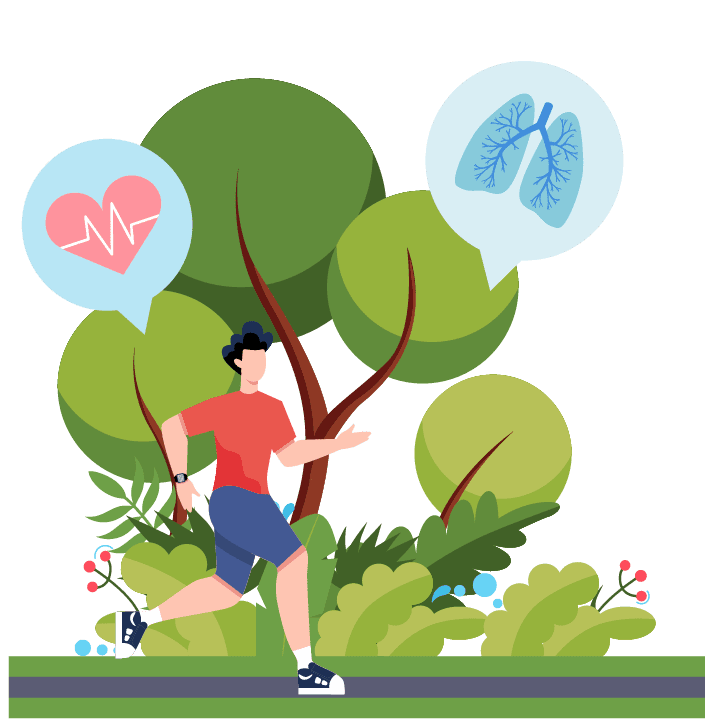
It’s a common misunderstanding that more air means more oxygen. But as awareness about the breath becomes more mainstream, athletes are catching on to the power of functional breathing.
In 2011, Christopher McDougall’s book, Born To Run told of the Tarahumara tribe in Mexico. Running is a way of life for the Tarahumara. Even into their late 60s, these people run an average 60 miles every day. But what makes them exceptional? They breathe in only through the nose.
In his 2019 book, Breath, the journalist James Nestor explored the work of the late Russian doctor, Konstantin Buteyko. From his clinical observations, Buteyko concluded that chronic hyperventilation contributed to many diseases. He noticed that sick people breathe hard. He asked the question, “Is the hard breathing caused by disease, or is disease the result of hard breathing?”
Chronic hyperventilation is a dysfunctional breathing pattern that involves over-breathing. When you breathe more air than your body needs, levels of carbon dioxide (CO2) in the blood drop below normal. Buteyko combined techniques from ancient yoga with scientific research. He devised a series of nasal breathing exercises to reduce breathing volume and make the body less sensitive to CO2.
In 2018, George Dallam ran an experiment. He tested recreational runners after they had trained for at least 6 months using only nose breathing. Blood gas readings showed higher carbon dioxide and better body oxygenation. Breathing was slower. The breathing muscles were not working so hard. Even though CO2 was higher, the runners were not getting so breathless. In fact, Dallam’s study found that nose breathing is a whopping 22% more efficient. This could make all the difference during endurance running.
Breathing Tips for Running: Balancing Your Blood Gases
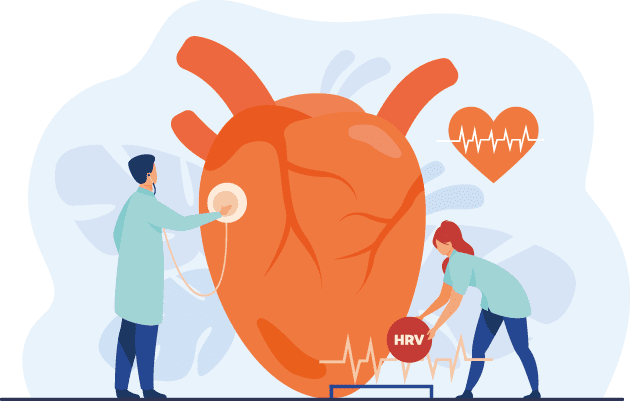
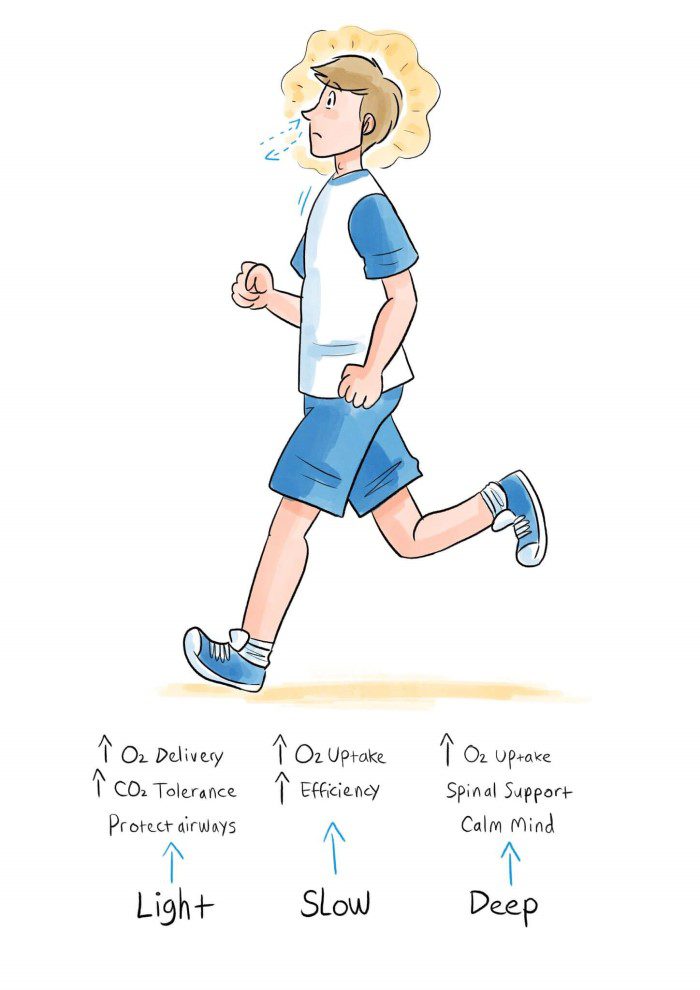
How Does Nasal Breathing Keep You Healthier?

Running keeps you healthy, right? Not necessarily. More athletes than non-athletes suffer from asthma. There’s a high incidence of respiratory infection among runners, particularly after competition. Studies have identified sleep apnea and poor heart health in young athletes. Fit does not always mean well. This links with the breath in several ways:
- Fast, hard breathing is normally upper chest breathing. It disrupts the balance of O2 and CO2. And it prevents your diaphragm from working properly.
- If you breathe into your chest when you run, you’ll experience poor core stability. Your breathing muscles will tire faster. Blood flow will divert from your legs to support your breathing. You are also more likely to get injured.
- Fast, hard mouth breathing doesn’t filter, warm, or moisten the air. Imagine you’re running near a road, breathing hard with your mouth open. You’re taking toxic particles straight to your lungs with every breath. The dry, cold air causes your airways to constrict, making breathing more difficult. It’s hardly surprising your asthma flares up.
- Nose breathing reduces mouth snoring, sleep apnea and insomnia. Sleep is essential for good health and recovery.
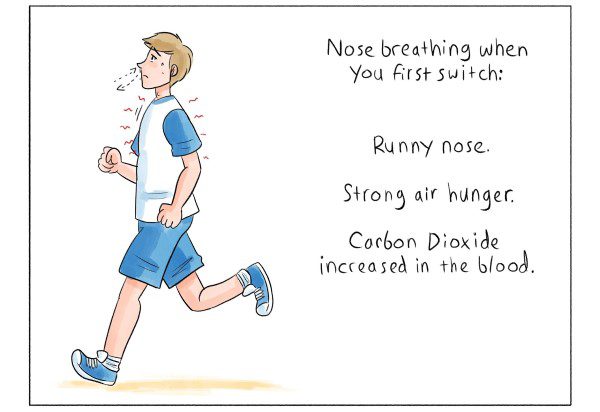
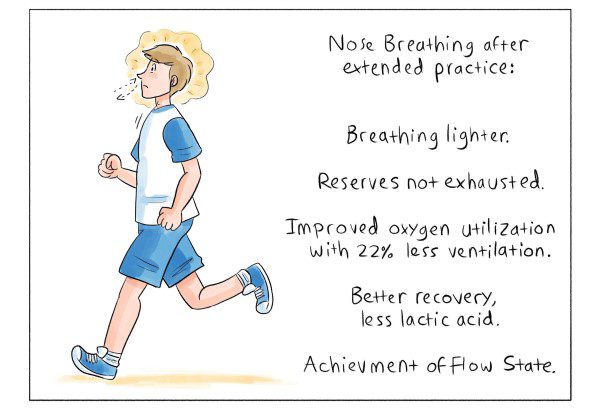
How to Maintain Nasal Breathing 24/7
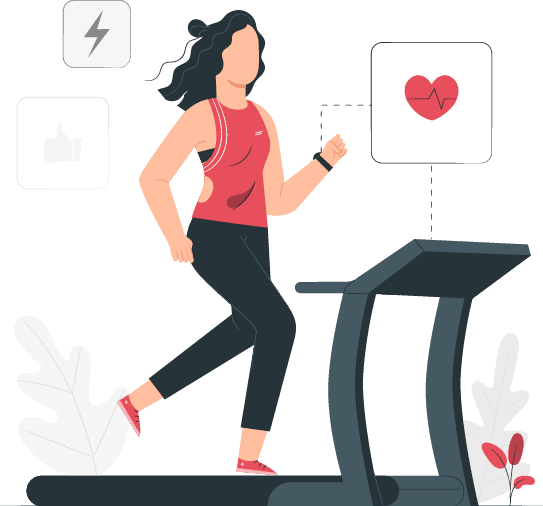
The Oxygen Advantage® method involves the practice of full-time nasal breathing. For recreational runners, it’s possible (and advisable) to maintain nose breathing all the time during training. Once your body has adapted, you can expect to achieve the same maximal workload.
If you feel as if you aren’t getting enough air, simply slow down and allow your breathing to normalize. It’s all about finding your pace. In James Nestor’s book, Breath, the author shares his experience of jogging with his mouth closed. He describes how he would experience the discomfort of intense breathlessness. But his pulse oximeter registered no decrease in blood oxygen saturation.
If you are a professional runner, you will need to mouth breathe some of the time. This will allow you to train hard enough to build muscle tone. If you try to maintain nose breathing while working at a high intensity, the air hunger will be too strong. It may also become impossible to control your breathing through the nose during very intensive exercise. Nasal breathing should not be too hard and fast. This can result in pain in the nasal airway.
Even for recreational runners, once your BOLT score is higher than 20 seconds, it is okay to breathe through your mouth some of the time. Remember Dallam’s study? After 6 months training with only nasal breathing, his runners breathed just as efficiently through the mouth as they did through the nose.
To get the balance right, pro runners should aim to breathe through the nose for at least 50% of training. And don’t deliberately “breathe big” for competition. Your nasal breathing practice during training will make your breathing more efficient when you need it most.
For the rest of the time, day, and night, keep your mouth closed to experience benefits including:
- Reduced snoring and sleep apnea
- Better heart rate variability
- Better mental focus
- Relief from airway trauma and asthma
- Less stress
Switching to nasal breathing takes patience. Complete adaptation will depend on how sensitive you are to CO2 (your BOLT score). And how diligently you practice nasal breathing.
How to Breathe While Running: What the Research Says
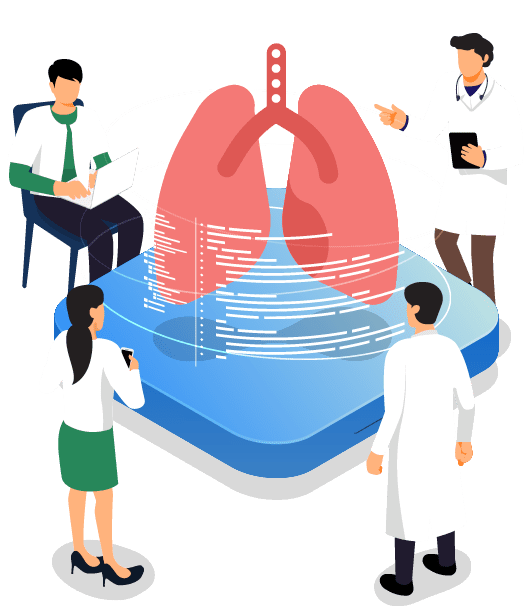
Q1. Why Do I Struggle to Breathe When Running?
You set off for a run. It’s a bright, cold morning, and you’re looking forward to getting out. But as you get into your stride, your breath becomes heavy. You begin wheezing, your chest tightens and burns as the cold air hits your lungs. And even though you don’t have asthma, you feel like you’re about to have an asthma attack.
Bronchoconstriction is a condition in which the smooth muscle in your lungs tightens. It causes breathlessness, wheezing and coughing. When these breathing symptoms are triggered by exercise, it’s called exercise-induced bronchoconstriction (EIB). EIB is a common problem for runners. It can be so severe it stops you exercising.
Scientists have shown that EIB is triggered by breathing cold, dry air straight into your lungs from your open mouth. Conversely, when you inhale warm, humid air, the airways remain clear [1]. Remember, your nose warms and humidifies air as you inhale. Which means you can reduce or prevent breathing symptoms simply by breathing through your nose.
Q2. How Does Breathing Change During Exercise?
During exercise, your body uses more oxygen. As your muscles warm up, they produce more carbon dioxide. Remember, carbon dioxide causes the hemoglobin in red blood cells to release oxygen to the working muscles, where the cells use it to make energy.
Because carbon dioxide provides the stimulus to breathe, your breathing alters relative to your CO2 production. This is called your hypercapnic drive. Your ability to sustain physical exercise, your stamina and your enjoyment while running, are all directly related to your sensitivity to changes in blood CO2.
As CO2 levels rise, the speed and volume of your breathing will increase. Breathing becomes effortful, and your heart begins to pound.
When running already makes you breathless, the idea of nasal breathing may seem ridiculous. Nasal breathing during running slows your breathing and reduces breathing volume. It causes blood CO2 to increase, which means more oxygen gets to your muscles. But it also means stronger air hunger, and that can feel unpleasant. By the time volume of air entering your lungs reaches about 35 or 40 liters a minute, you are desperate to open your mouth to breathe [2].
Mouth breathing is faster. It helps you take in a larger volume of air. It feels more comfortable when exercise is intense. And as you blow off more air during exhalation, CO2 levels drop, reducing your feelings of air hunger [3].
But, if you can maintain nasal breathing while running, your lungs will be able to extract more oxygen from the air you breathe. This will lessen your feelings of air hunger through better oxygenation.
Of the two, the second is the more efficient. At first, it will be tough. You’ll feel strong air hunger and your nose will run. Bring a tissue. If you continue to practice nasal breathing for 6 to 8 weeks, the air hunger will subside. Your body will adapt. And your breathing will become lighter and more efficient. It will become easier to breathe through the nose all the time.
Q3. What’s the Best Breathing Technique for Running Endurance?
Research has shown that low sensitivity to CO2 is one factor that sets outstanding endurance athletes apart from their less successful rivals [4].
Scientists have been exploring the relationship between low sensitivity to CO2 and exceptional athletic performance in endurance sports since 1979 [5]. A 2007 study by the biologist and physical education expert, Xavier Woorons, found that reduced sensitivity to blood CO2 allowed trained men to breathe more slowly, at sea level and during altitude simulation [6].
Many of us believe that we can lessen breathlessness by training intensively. But our capacity for exercise is limited by the strength of our breathing muscles. Meaning most of us will never be able to train hard enough to achieve this. But we can alter our sensitivity to CO2 using simple breathing exercises.
Q4. Exactly How Much More Efficient Is Nasal Breathing While Running?
Remember our exercise-science expert George Dallam? To adapt to nose breathing, his runners had trained for 6 months. Dallam recorded results when the runners breathed through the nose, and when they breathed through the mouth. Let’s look at his findings…
- During nose breathing, the breathing rate was 39.2 breaths per minute. During mouth breathing it was 49.4 breaths per minute.
- The percentage of CO2 in exhaled air (called end tidal carbon dioxide) was much higher in the nose breathing trial (44.7mmHg compared with 40.2mmHg in mouth breathing).
- There was less oxygen in exhaled air because more oxygen was being absorbed into the bloodstream.
- Because the runners had trained for 6 months using nose breathing, they breathed more slowly. This enabled them to achieve the same optimum oxygen consumption when they were mouth breathing. Slower breathing gives more time for oxygen to diffuse into the blood. Air is pulled deeper into the lungs, and it stays there longer.
- The study proved it is possible to maintain VO2 max and peak performance following a period of training using only nasal breathing.
- Dallam concluded that nasally restricted breathing during running may be beneficial for endurance athletes who want to boost their performance and maintain good respiratory health [3].
- This is backed up by previous research which demonstrates that air hunger can be lessened using exercises that increase end tidal CO2 and push feelings of air hunger beyond normal, comfortable levels [7].
Q5. How Can I Train My Breathing Muscles, and What Does the Diaphragm Have to Do with Running Anyway?
When you exercise intensively, your muscles work harder. This applies to your breathing muscles, just as it does to your leg muscles. When a muscle works harder, it needs more oxygen. And just like your legs, your breathing muscles can get tired. Especially during endurance running. Because humans are wired for survival, your body will always prioritize breathing. So as your breathing speed and volume increase and you approach your maximal exercise threshold, your body diverts blood flow from the legs to support your diaphragm. This rerouting of blood away from your legs is called the metaboreflex. It makes your legs tired and wobbly, forcing you to slow down and stop.
Your sensitivity to CO2 impacts your breathing muscles too. If your BOLT score is low, you breathe harder when exercise intensifies. Breathing hard requires more work from the breathing muscles. They get tired more quickly. To complicate things further, when the respiratory muscles overwork, metabolic by-products like lactic acid collect in the tissues, affecting your circulation. Studies into breathing techniques have shown that when breathing is easier, blood flow to the legs improves by as much as 7% [8].
Any attempt to improve breathing for running should involve strengthening the breathing muscles. To strengthen a muscle, you need to work that muscle harder than normal. This is tricky with the breathing muscles. Even when you work out intensively, it’s not possible to sustain intensive exercise for long enough to make a difference.
The diaphragm is a striated muscle. It’s the same type of muscle as the muscles that move your joints. The most reliable way to strengthen any striated muscle is to use it. And then to add a load to that use.
But how do you add a load to breathing?

Nose breathing while running engages the diaphragm. Mouth breathing doesn’t. Another nail in the coffin for mouth breathing…
The diaphragm is an inspiratory muscle. It’s active on inhalation and largely passive during exhalation. You can train your inspiratory muscles by inhaling against resistance. You can add a load to your breathing muscles by switching to nasal breathing while running. But you can extend the practice by using a resistance mask like SportsMask.
SportsMask has an adjustable valve opening. This allows you to condition your breathing muscles, and it works the same way as any other progressive muscle training program.
This technique is called IFRL or inspiratory flow resistive loading. IFRL can increase the strength of your breathing muscles by up to 50%.
Breathing Exercises for Running

You can use the Oxygen Advantage® exercises with or without elevation training mask to strengthen your diaphragm. Specifically, the strong breath holding exercises to simulate training at high altitude.
When you hold your breath to achieve strong air hunger, your body can’t remove excess carbon dioxide from the lungs. During the breath hold, your cells continue to work to diffuse oxygen. The result is a combination of high blood carbon dioxide – called hypercapnia — and low blood oxygen — called hypoxia. You can read more about intermittent hypoxic/hypercapnic training by browsing our science pages.
The body’s natural state is homeostasis. And so, it puts mechanisms in place to restore normal blood gas levels. Your diaphragm begins to send messages to the brain to resume breathing. As the breath hold continues, these messages become more urgent, and the diaphragm begins to contract again and again. By holding your breath, you give your diaphragm a workout.
What’s the Best Way to Integrate Nasal Breathing into Your Training?

- Start by slowing everything down to a level where you feel a light air hunger. Gradually increase exercise intensity as the feeling of air hunger goes away. Track your progress using your BOLT score.
- A progressive warm up, and indoor training on a treadmill or indoor bike can be helpful too. The Oxygen Advantage® nasal breathing and breath holding exercises are easy to integrate into your training regimen.
- Pay attention to your breathing. Notice whether you breathe through your mouth. What happens when you are running? Check your BOLT score to see how sensitive you are to CO2. If you score less than 25 seconds, you are likely to experience muscle fatigue much sooner in your run.
- Practice the exercise to unblock your nose. Most people who mouth breathe do so because the nose is blocked. If you can breathe through your nose for one minute, you can do so for life.
- If you find it hard to breathe through your nose during exercise, slow down until your breathing has normalized. You might find it helpful to use MYOTAPE Sport to tape your lips. If you have a deviated septum, NasalDilator will help keep your airways open.
- Use MYOTAPE to tape your mouth at night and ensure nasal breathing during sleep. This helps relax your nervous system, keeps your mouth healthy and improves sleep quality and recovery.
The breath offers a doorway to your full potential. But when you first make the switch, everything will feel different. Be patient. The body needs time to adapt. Within a short time, you will notice improvements in exercise recovery. You’ll experience reduced asthma symptoms. And you will find your stamina and focus increase. And remember. The best breathing techniques for running always start with the nose.
References:
- Strohl, KINGMAN P., MICHAEL J. Decker, LESLIE G. Olson, T. A. Flak, and PETER L. Hoekje. “The nasal response to exercise and exercise induced bronchoconstriction in normal and asthmatic subjects.” Thorax 43, no. 11 (1988): 890-895.
- Niinimaa, V. P. S. R. J., P. Cole, S. Mintz, and R. J. Shephard. “The switching point from nasal to oronasal breathing.” Respiration physiology 42, no. 1 (1980): 61-71.
- Dallam, George M., Steve R. McClaran, Daniel G. Cox, and Carol P. Foust. “Effect of Nasal Versus Oral Breathing on Vo2max and Physiological Economy in Recreational Runners Following an Extended Period Spent Using Nasally Restricted Breathing.” International Journal of Kinesiology and Sports Science 6, no. 2 (2018): 22-29.
- McGurk, S. P., B. A. Blanksby, and M. J. Anderson. “The relationship of hypercapnic ventilatory responses to age, gender and athleticism.” Sports medicine 19, no. 3 (1995): 173-183.
- Martin, BRUCE J., KENNETH E. Sparks, CLIFFORD W. Zwillich, and JOHN V. Weil. “Low exercise ventilation in endurance athletes.” Medicine and science in sports 11, no. 2 (1979): 181-185.
- Woorons, X., P. Mollard, A. Pichon, C. Lamberto, A. Duvallet, and J‐P. Richalet. “Moderate exercise in hypoxia induces a greater arterial desaturation in trained than untrained men.” Scandinavian journal of medicine & science in sports 17, no. 4 (2007): 431-436.
- Bloch-Salisbury, Elisabeth, STEVEN A. Shea, R. O. B. E. R. T. Brown, Karleyton Evans, and Robert B. Banzett. “Air hunger induced by acute increase in PCO2 adapts to chronic elevation of PCO2 in ventilated humans.” Journal of Applied Physiology 81, no. 2 (1996): 949-956.
- Amann, Markus. “Pulmonary system limitations to endurance exercise performance in humans.” Experimental physiology 97, no. 3 (2012): 311-318.